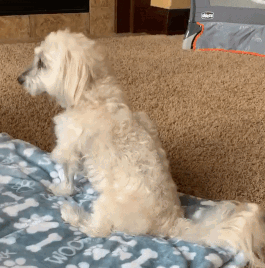

The wag of a tail can mean a lot of different things for a dog. He can be happy, want to tell others he’s tired of playing or when they’re puppies, let their mother know they would like to be fed.
In the case of Oliver, a seven-year-old Maltese mix, a little movement in his tail meant he was on the road to recovery.
This past spring, Oliver was living a normal dog’s life in Pocahontas, Iowa. On the day of his incident, he even went on a long afternoon walk with his owners Joann and Alan. That evening, he jumped off the couch, yelped and started dragging his back legs.
In a matter of moments, all of Oliver’s legs became weak and he was unable to walk. Joann and Alan brought Oliver to the Hixson-Lied Small Animal Hospital where the dedicated Emergency and Critical Care Team began to assess his condition.
“Oliver was paralyzed from the neck down,” said Dr. Maude Poirier, a resident in the Hixson-Lied Small Animal Hospital. “When we looked at him, we could also see he was not able to move his chest wall to breathe and his blood work showed an elevated carbon dioxide level.”
Poirier attributed the increased levels to weakness of the nerves that control the breathing muscles – the diaphragm and intercostal muscles. These nerves travel along the spinal cord in the neck.
If an injury to the spinal cord in the neck is severe enough and causes tetraplegia, affected humans and dogs can have trouble breathing on their own, as the breathing muscles cannot move to expand the lungs.
Such was the case for Oliver.
Fortunately for Oliver, the Hixson-Lied Small Animal Hospital has a ventilator and he was rapidly anesthetized, intubated and placed on a ventilator.
Oliver underwent an emergency MRI to understand what had happened. Poirier says the dog suffered from a very specific type of intervertebral disk disease known by several names include missile or high velocity, low-volume disk injury.
Intervertebral disks are the cushions located between the vertebrae and act to absorb shock during normal movement of the spine. Sometimes, the outer layer of the disk can rupture suddenly, and a very small amount of disk is projected against the spinal cord, injuring it without causing compression.
“Oliver couldn’t breathe by himself but there was nothing we could directly do about it,” Poirier said. “The biggest thing he needed was time and a lot of rehabilitation therapy. Luckily for him, he improved quickly enough that he was only on the ventilator for 24 hours.
“He was receiving intensive pain management and steroids to improve his comfort and help with the inflammation, but surgery was not recommended as his symptoms were mainly caused by the trauma and bruising to his spinal cord.”
Poirier says that while disk disease in small dogs is pretty common, veterinarians typically deal with a type of disk disease that is different from what Oliver was suffering from.
“Luckily, Oliver is a small dog which made it easier to manage and rehabilitate than if he had been say a Great Dane,” she said. “His owners were also extremely committed and wanted to give him a chance to recover.”
Oliver was tetraplegic for ten days before he moved his tail for the first time since his injury. He was hospitalized for two weeks before he went home. On the day he was discharged, he was still unable to sit or stand but he finally showed some movement in his back legs.
“Oliver has made huge strides since leaving the hospital,” Poirier says. “ It has now been a month since his injury and he is able to stand and take a few steps with support.
“He has regular swimming sessions to strengthen his legs and other exercises he does with his owners multiple times a day to make sure his legs remain strong. At this point, we anticipate Oliver will keep on improving and will be able to walk on his own in the new few weeks.”
June 2020
